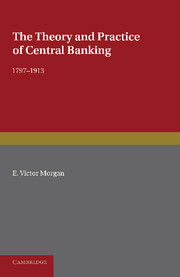Book contents
- Frontmatter
- Contents
- Tables
- Editorial Preface
- Author's Preface
- Chapter I Banks and Banking in the Early Nineteenth Century
- Chapter II The Bank Restriction Period, 1797–1821
- Chapter III Monetary Theory of the Bank Restriction Period
- Chapter IV The First Years of Resumption, the Crisis of 1825, and the Bank Charter Act, 1833
- Chapter V The Horsley Palmer Experiment, and the Bank Charter Act, 1844
- Chapter VI The Currency and Banking Controversy
- Chapter VII The Trial of the Bank Charter Act, 1844-58
- Chapter VIII The Great Boom, 1858-73
- Chapter IX The Great Depression, 1873-96
- Chapter X The Last Years of the Gold Standard, 1897–1913
- Chapter XI Monetary Theory of the Second Half of the Nineteenth Century
- Appendix Changes in Bank rate, 1876-1913, with the Amount of the Reserve of the Banking Department and the “Proportion” on the preceding Wednesday
- Index
Chapter VIII - The Great Boom, 1858-73
Published online by Cambridge University Press: 05 June 2016
- Frontmatter
- Contents
- Tables
- Editorial Preface
- Author's Preface
- Chapter I Banks and Banking in the Early Nineteenth Century
- Chapter II The Bank Restriction Period, 1797–1821
- Chapter III Monetary Theory of the Bank Restriction Period
- Chapter IV The First Years of Resumption, the Crisis of 1825, and the Bank Charter Act, 1833
- Chapter V The Horsley Palmer Experiment, and the Bank Charter Act, 1844
- Chapter VI The Currency and Banking Controversy
- Chapter VII The Trial of the Bank Charter Act, 1844-58
- Chapter VIII The Great Boom, 1858-73
- Chapter IX The Great Depression, 1873-96
- Chapter X The Last Years of the Gold Standard, 1897–1913
- Chapter XI Monetary Theory of the Second Half of the Nineteenth Century
- Appendix Changes in Bank rate, 1876-1913, with the Amount of the Reserve of the Banking Department and the “Proportion” on the preceding Wednesday
- Index
Summary
GENERAL CHARACTERISTICS
The general characteristics of the period 1858–73 are too familiar to need detailed description. Prices and wages were rising, in spite of occasional checks, unemployment was low and industry and trade, especially foreign trade, were rapidly expanding. Foreign investment, both in railway building and in government loans, was increasing, and we had a large favourable balance of payments on income account. The world stock of gold was growing fast, but the metal was being drawn into circulation as soon as it was coined, and central bank reserves remained low, and rates of interest high.
The various price indices show discrepancies in detail, but give the same general impression. The Sauerbeck food index fell from 98 in i860 to 88 in 1864, but rose to 107 in 1873. The Sauerbeck raw material index rose from 100 in i860 to 119 in 1864, fell to 99 in 1868, rose again to 115 in 1872, and fell to 114 in the next year. The Economist index rose from 123 in i860 to 172 in 1864, fell to 117 in 1868, and rose to 134 in 1873. The years 1860-8 reveal the pattern with which we are familiar— rapidly rising prices, followed by credit stringency, a slight fall in prices, monetary crisis, and then a sharp fall in prices as traders make distress sales. In 1873 both the rise and the fall in prices was less marked and the crisis less severe, as disturbances on the Continent checked the inflationary forces before they had time fully to develop.
The Trade Union unemployment figure averaged just under 4-7%. Unemployment was high in 1858, as a result of the crisis of 1857, in 1861–3, owing to the dislocation caused by the American Civil War, and in 1867–9, following the crisis of 1866. In all other years it was below 4%, and in 1873 it fell as low as 0–9%. Mr G. H. Wood's wage index shows an almost continuous rise from n o in 1858 to 155 in 1873: the rise was the sharpest during the two periods of expanding trade but there is practically no decline in the intervening depression.
- Type
- Chapter
- Information
- The Theory and Practice of Central Banking, 1797–1913 , pp. 165 - 186Publisher: Cambridge University PressPrint publication year: 2013



